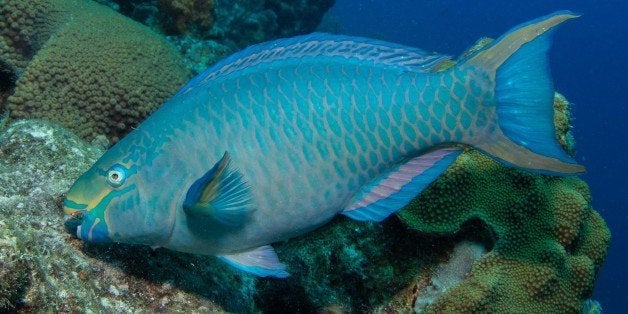
The tragedy of the commons is thriving in our oceans. A fisherman aiming to maximize profit or provide for his family contributes to over-harvesting. A community looking to cut costs turns a blind eye to wastes entering coastal waters. Billions of people around the world make rational decisions like these every day based on their historical practices and economic interests -- and it's adding up to gigantic shifts in the abundance and diversity of ocean life.
Achieving the United Nation's Sustainable Development Goal #14 will require nothing less than restructuring the relationship between humanity and the oceans. It is right to place significant emphasis on creating economic value for ocean stakeholders, like local populations that depend on fishing or Small Island Developing States. It is this value that creates an opportunity for management and conservation actions that protect and restore marine life. But what does this look like in reality?
I just returned from a visit to the island of Bonaire in the Caribbean, where a set of management policies and practices have been established that emphasize managing ocean resources to meet multiple long-term economic interests. Bonaire is a scuba-divers paradise, where the expenditure by tourists is estimated around $125 million annually. Bonaire has a strong interest in maintaining tourism as part of its economic future, and it has acted to protect this interest while working to balance competing interests, like fishing.
Bonaire has set aside specific reef areas where fishing is not allowed. In other places, artisanal fisheries are allowed using a restricted set of gear (hook and line). One of Bonaire's most significant rules is that grazing fish, like parrotfish, which help keep the reef healthy and clean for corals, and other kinds of ocean life, are universally protected. Under this system, everyone benefits: the tourism industry has incentives to support these practices, because their livelihoods depend on healthy reefs; fisherman are allowed to continue to fish for many species in most of the islands waters, and the ocean ecosystems benefit from having abundant parrotfishes and other marine life.
On top of it all, the management and enforcement system in Bonaire is financed by tourists who pay a fee to visit the reef. While Bonaire's approach is not perfect, it demonstrates the power of designing systems that provide benefits to different user groups, while ensuring that management actions have sustainable, long-term financing.
Bonaire's actions yield benefits locally and provide a conservation blueprint for other coral-reef regions around the world. Indeed, their pioneering efforts over the last few decades have inspired similar efforts in many other places. For example, the Namena Marine Reserve in Fiji and the Sandy Bay West End Marine Protected Area in Honduras both include management and financing systems that are built on Bonaire's example. And in both of these locations, management actions are yielding positive results for marine life.
Achieving the ambitious goals put forth by the UN is possible. Examples like Bonaire help demonstrate what it will take: the establishment of rules and management systems that are designed to promote economic opportunity via sustainable use. When economic interests and sustainable use are aligned, the rational choice will be the right choice for the future of our oceans.
This post is part of a series produced by The Huffington Post, "What's Working: Sustainable Development Goals," in conjunction with the United Nations' Sustainable Development Goals (SDGs). The proposed set of milestones will be the subject of discussion at the UN General Assembly meeting on Sept. 25-27, 2015 in New York. The goals, which will replace the UN's Millennium Development Goals (2000-2015), cover 17 key areas of development -- including poverty, hunger, health, education, and gender equality, among many others. As part of The Huffington Post's commitment to solutions-oriented journalism, this What's Working SDG blog series will focus on one goal every weekday in September. This post addresses Goal 14.
